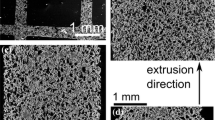Abstract
An electron microscope study was made to determine the effect of mechanical compaction method on the fabric produced in a compacted commercial kaolin. Direct platinum-shadowed carbon replicas were made from horizontal and vertical fracture surfaces within the middle third of cylindrical specimens compacted by static load, impact, and kneading compaction at optimum moisture content and at 3% above and below optimum. Replicas were studied in the electron microscope to arrive at a qualitative evaluation of fabric. No oriented fabric or edge-to-face random fabric of individual particles, as postulated by others, was found. Regardless of compaction method the fabric was found to consist of parallel and random arrangements of packets of kaolin flakes. Both impact and kneading compaction produced essentially the same fabric consisting of trajectories of parallel packets, probably the result of shearing deformation during compaction, within essentially randomly oriented zones of packets. Static load compaction produced a fabric in which some tendency of the packets to orient normal to the direction of loading was apparent. For all compaction methods some increase in parallel packet orientation was noted with increase in molding water content. The mode of parallel orientation differed between static load compacted specimens and those produced by either impact or kneading compaction. Results of the study indicate that some revision of concepts regarding particle orientation due to mechanical compaction should be made.
Similar content being viewed by others
References
Aylmore, L. A. G., and Quirk, J. P. (1962) The structural status of clay systems, Clays and Clay Minerals, Proc. 9th Conf., Pergamon Press, New York, pp. 104–30.
Bradley, D. E. (1954) Evaporated carbon films for use in electron microscopy: British Jour. Appl. Phys. 5, 65.
Bradley, D. E. (1958) Simultaneous evaporation of platinum and carbon for possible use in high resolution shadow-casting for the electron microscope: Nature, 181, 875.
Casagrande, A. (1932) The structure of clay and its importance in foundation engineering: Jour. Boston Soc. Civ. Engrs., 19, 168–209.
Goldschmidt, V. M. (1926) Undersokelser over lersedimenter: Nordisk jordbrugsforskning, nos. 4-7, pp. 434–45.
Jaffe, M. S. (1948) Auxiliary supporting nets for fragile electron microscopy preparations: British Jour. Appl. Phys. 19, 1191.
Lambe, T. W. (1953) The structure of inorganic soils: Proc. Amer. Soc. Civ. Engrs., Separate No. 315, New York 49, pp.
Lambe, T. W. (1958a) The structure of compacted clay: Jour. Soil Mech. and Fdns. Div., Am. Soc. Civ. Engrs. 84, No. SM-2, 1654-1 through 1654-34.
Lambe, T. W. (1958b) The engineering behavior of compacted clay: Jour. Soil Mech. and Fdns. Div., Am. Soc. Civ. Engrs. 84, No. SM-2, pp. 1655-1 through 1655-35.
Meade, R. H. (1964) Removal of water and rearrangement of particles during the compaction of clayey sediments—review: U.S. Geol. Survey Prof. Paper 497-B, 23 pp.
Michaels, A. S. (1959) Discussion to: physico-chemical properties of soils: soil-water systems: Jour. Soil Mech. and Fdns. Div., Am. Soc. Civ. Engrs. 85, No. SM-2, part 1, pp. 91–102.
Mitchell, J. K. (1956) The fabric of natural clays and its relation to engineering properties: Proc. 35th Highway Research Board, NAS-NRC 35, 693–713.
Rosenqvist, I. Th. (1955) Investigations in the clay-electrolyte water system: Publ. Norwegian Geotechnical Inst., No. 9, Oslo, 125 pp.
Rosenqvist, I. Th. (1959) Physico-chemical properties of soils: soil-water systems: Jour. Soil Mech. and Fdns. Div., Am. Soc. Civ. Engrs. 85, No. SM-2, part 1, 31–53.
Rosenqvist, I. Th. (1962) The influence of physico-chemical factors upon the mechanical properties of clays: Clays and Clay Minerals, Proc. 9th Conf., Pergamon Press, New York, pp. 12–27.
Seed, H. B., and Chan, C. K. (1959) Structure and strength characteristics of compacted clay: Jour. Soil Mech. and Fdns. Div., Am. Soc. Civ. Engrs., 85, No. SM-5, 87–128.
Tan, T. K. (1957) Discussion on: soil properties and their measurement: in Proc. 4th Int. Conf. on Soil Mech. and Fdn. Eng III, London, pp. 87–89.
Terzaghi, K. (1925) Modern conceptions concerning foundation engineering: Jour. Boston Soc. of Civ. Engrs. 12, no. 10, 1–43.
Trollope, D. H., and Chan, C. K. (1960) Soil structure and the step-strain phenomenon: Jour. Soil Mech. and Fdn. Div., Am. Soc. Civ. Engrs. 86, no. SM-2, Part I, 1–39.
Author information
Authors and Affiliations
Rights and permissions
About this article
Cite this article
Sloane, R.L., Kell, T.R. The Fabric of Mechanically Compacted Kaolin. Clays Clay Miner. 14, 289–296 (1966). https://doi.org/10.1346/CCMN.1966.0140125
Published:
Issue Date:
DOI: https://doi.org/10.1346/CCMN.1966.0140125



